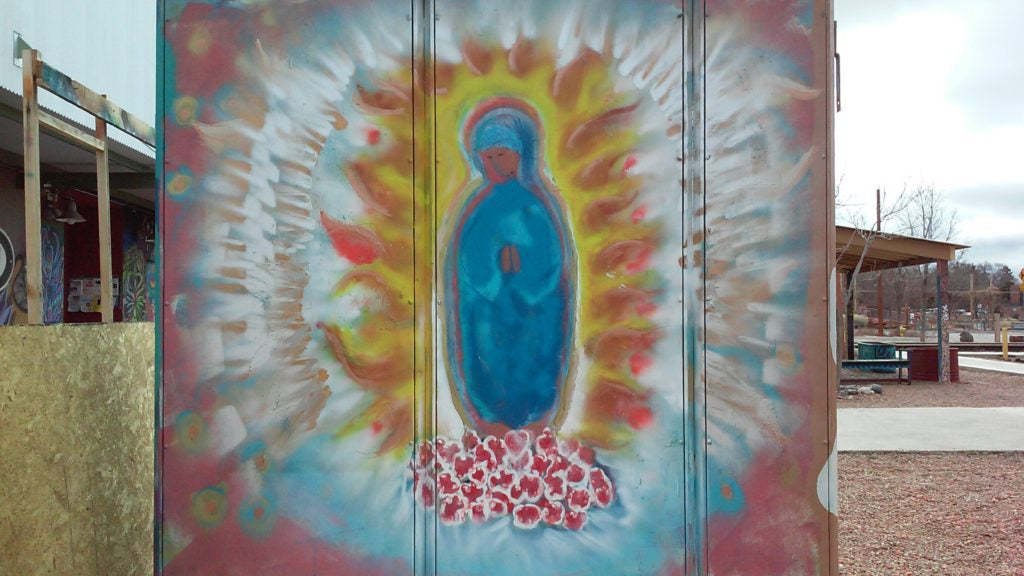https://youtu.be/yAZgWXWGgwE
Doing a comparison of Street Art and Fine Art one would assume that Street Art doesn't have the same qualities of fine art. Many people that walk past Street Murals only see colorful shapes that breakup the bland urban scape. They don't realize that they are looking at fine art. We will first define what Fine Art is, next describe what Street Art is, and finally justify why we can call Street Art on the same level of fine art.
Fine Art Defined
Fine Art defined as: "an art form created mainly for its aesthetic value and its beauty ("art for art's sake") rather than its functional value. Fine art is rooted in drawing and design-based works such as painting, printmaking, and sculpture. It is often contrasted with "applied art" and "crafts" which are both traditionally seen as utilitarian activities. Other non-design-based activities regarded as fine arts, include photography and architecture, although the latter is best understood as an applied art."

Street Art Defined
Street art, in contrast, bursts into public spaces with untamed energy and vibrancy. They're massive in scale and seem to expand beyond the confines of the buildings, walls, and bricks on which they're created. They are figurative, abstract, and everything in between, Viewing street art is a radically different experience than exploring fine art in a museum context. When Street Art is painted onto something it incorporates the architecture, space, material, and location.

Techniques to Create
Art techniques have been used as a vehicle to see, understand, and talk about art. They can radically change the perception, context, and meaning of artwork without trying. Oil paint, for example, is an art technique that automatically elevates a work into the fine art sphere because it has been a major technique used to create so much fine art. However, technique can only go so far as to define an artwork as fine art. There has been many bad artwork created using fine art techniques.
However, when a Street Art Mural is produced it is usually with spray paint or other all weather paints. And, since it is in a public space many viewing it will simply call it "graffiti." And if the viewer likes or doesn't like what they see it is easy to diminish the art as not being fine art. Both art techniques are forms of painting, Both come with the same kinds of color and compositional choices.

Museums Will Always Decide What Art is Seen

When we visit a museum it is the curators who has decided for us what we see. They explore a relatively limited number of narratives in history. Research shows that 85% of artists in U.S. museum collections are white, and 87% are male. Neither of those numbers detracts from the beauty, skill, and culture that permeates the nation's artworks. It just means that there are thousands of other stories to tell, experiences to witness, and historical moments to learn from.
Street Artwork Reflects Diversity and Society

Street art allows for diversity and inclusivity in the narratives that are portrayed in art. Both by the images that we see and the artists that create the work. Regardless of whether the work of art is utterly abstracted or hyper-realistic, it's still a snapshot of the community and culture from which it was made. In many ways, street art is the world's museum, and we all have the privilege of seeing artworks crop up and react to life in real-time.
Street Art Responds to Stress and Fears


During the COVID-19 pandemic, graffiti and street artists have created moving and impactful images and messages about our first responders. Street art expresses what people feel and believe in our current cultural moment as it occurs, and it is enthralling to see.
In many ways, street art is the world's museum, and we all have the privilege of seeing artworks crop up and react to life in real-time. During the COVID-19 pandemic, graffiti and street artists have created moving and impactful images and messages about our first responders. Street art expresses what people feel and believe in our current cultural moment as it occurs, and it is enthralling to see.
A Modern Way to Express Religious Views
Street art also takes on religious and sacred themes and has created modern sacred art. This has led to an even wider breath of discussion and engaging in a conversation about religion and expressing faith.
Street art is able to transforms a place into a place of worship. Going beyond the painting or a piece of architecture: it's a reflection of our shared culture, full of joy and energy. It lives and breathes along with the city's inhabitants. It has as many religious themes and connotations as any work of fine art from the 17th century.


A Fundamental Difference
This is perhaps one of the only fundamental differences between street art and fine art. Street art injects art directly into the public sphere. It endures all kinds of weather, human interaction, and daily activity, yet it continues to stand firm and unscathed. Have you ever run your hand across some painted bricks or marveled at the sheer scale and the countless hours that went into a street art mural? It's the best feeling. Whether it's graffiti or oil paint, both fine art and street art infuse the act of painting with dignity, human experience, and culture. These art techniques have more in common than we give them credit for; they allow us to learn about the state of our world and enjoy the endless capacity of human creativity.

